No products in the cart.
First Aid/PPE
What Are The Levels Of Full Body Protection PPE?
The different levels of protection that a person can wear to protect themselves from chemical, biological, and radiological hazards are called Personal Protective Equipment or PPE.
Different materials can be used for various purposes: some offer better protection against physical hazards while others protect us against chemical threats or biological agents like radioactive dust, bacteria, and viruses; some last longer while other material needs to be replaced after only limited use due to environment substances they absorb from contact with water or oil-based fluids’ oils during operation under challenging conditions.
The three main types of body protection PPE are coveralls, respirators, and gloves. Coveralls will protect the entire body except for the head while wearing a respirator. Gloves provide hand protection while covering your whole arm up to your elbow with an elastic bandage material like latex or nitrile rubber; this will keep pathogens off of your hands when coming into contact with contaminated surfaces during cleanup efforts.
Respirators come in two forms: filtration (or air-purifying) masks that filter out most airborne particles such as dust, smoke particles, and microorganisms.
Coveralls
PPE coveralls are usually available in a variety of sizes and colors. For instance, some coveralls are designed for men, while others may be more appropriate for women because they have shorter sleeves or different style pant legs.
Skin
Skin protection is the most important type of body protection PPE.
The skin is our first line of defense against pathogens and potentially hazardous chemicals in the environment, so it’s crucial that you avoid contact with them.
It’s essential to wear gloves when handling infectious or contaminated materials as a protective barrier for your hands. Still, there are also options like Cangardcare coveralls which will protect you from head-to-toe if necessary.
If this sounds extreme, remember that some substances can be dangerous even at low concentrations; respirators should always be worn when working around such toxins (including biohazards).
Eye Protection
Eye protection is a must for many industries, and it’s vital to wear goggles or safety glasses when there’s any risk of liquids splashing into the eyes.
Head Protection
A hat will protect not only your scalp but also parts of your neck and ears.
Leg protection
Using bootees or coveralls to protect your legs and feet will make it easier for you to do your job.
Foot protection
Protection from the elements is essential, so wear appropriate shoes or boots when outside. This might sound like much work, but just wearing gloves will be enough in many cases.
There are also options like Cangardcare coveralls which will protect from head-to-toe if necessary.
If this sounds extreme, remember that some substances can be dangerous even at low concentrations; respirators should always be worn when working around such toxins (including biohazards).
Respirator
The types of respirators depend on the level of protection needed from breathing hazards such as chemicals or radioactive particles that could cause serious health problems if inhaled into your lungs.
To better protect yourself during a radiological emergency, you should wear an air-purifying full facepiece respirator which has been fitted to your face by either our respiratory specialist at work or by medical personnel trained in fitting them correctly; this type will filter out both gases and solid particulates like dust and smoke. You can ask your employer for a respirator fit test.
The next level of protection, called an air-supplying respirator or self-contained breathing apparatus (SCBA), is for use in environments where there may be insufficient oxygen to breathe without assistance, such as smoke from fires, contaminated air with unknown chemical content, and other hazards; it provides you with fresh air through a tank carried on your back, which has additional supplies of compressed gas that can sustain you outside the protective area until it becomes safe to return.
Finally, when protecting against radioactive particles, we recommend using a Powered Air Purifying Respirator (PAPR) because these types are needed for radiological emergencies involving alpha radiation emissions like those found at Chernobyl. The PAPR filters out contaminants in the air and uses a powered fan to circulate filtered air around the face and body.
Gloves
Gloves are one of the essential types of PPE. They are worn to protect infectious agents and work with hazardous materials, chemicals, etc., that could make the hands dirty or injure them. There are two different types:
– Chemical protective gloves use a variety of substances such as silver nitrate and formaldehyde
– Protective Barrier Gloves are designed to protect workers from high voltage electrical currents like those found on live wires after an accident. These gloves have extra insulation to prevent electric shock injuries by insulating worker’s arms up to their elbows. The most commonly used is PVC rubber-type glove (I don’t know if there is a specific name).
The choice of appropriate equipment depends on many factors – What you need it for? Where are you using it? What is the risk of exposure to chemicals or hazardous materials?
Different levels of protection are used for various purposes – and each level has a specific set of features:
– Level A, which offers complete body coverage. This means that it will cover your head, neck, torso, arms (including wrists), and legs from below the knees down. You can use this type if you need to protect yourself against any hazards during work with possible skin contact;
– Level B PPE suits provide more protective parts than those in Level A. These include gloves on both hands as well as bootees overshoes so that they offer extra protection for every part of your lower limbs while still keeping full limb mobility. The suit protects not just your hands and legs but also your torso and arms.
– Level C offers complete body coverage, but it is lighter than Level A equipment. This means that you will be able to move more quickly in this type of protection suit – such as if you need to work on a high ladder when installing or maintaining electrical wiring.
-Level D is the lightest weight, which is designed for those who work in clean areas where there are no possible hazards or risks.

